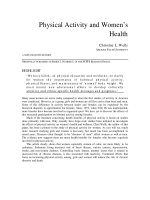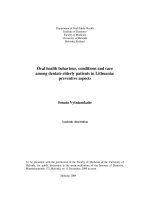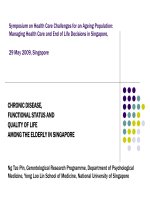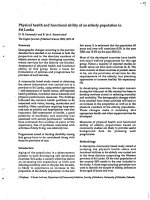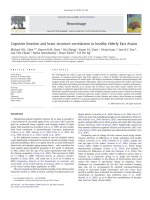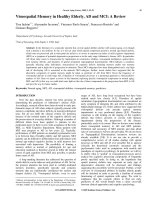EXERCISE AND PHYSICAL ACTIVITY AMONG HEALTHY ELDERLY IRANIANS pptx
Bạn đang xem bản rút gọn của tài liệu. Xem và tải ngay bản đầy đủ của tài liệu tại đây (231.31 KB, 12 trang )
SoutheaSt aSian J trop Med public health
444
Vol 42 No. 2 March 2011
Correspondence: Anoosheh Monireh, Depart-
ment of Nursing, Faculty of Medical Science,
Tarbiat Modares University, Jalal-e-Al Ahmad
Ave, Teharan, Islamic Republic of Iran.
Mobile: 0098 9125885702; Fax: 0098 2182883856
E-mail:
INTRODUCTION
The increase in life expectancy be-
cause of socioeconomic progress has
produced a population of elderly people
that is growing in size throughout the
world (Tas et al, 2007) including in Iran.
The elderly in Iran are expected to reach
14.7% of the population by 2025 (Mirzaei
and Shams, 2007).
The increase in the elderly popula-
tion has medical and economical conse-
quences for the individuals and society
(Tas et al, 2007). The inability to carry out
some physical activities, such as bathing,
dressing, toileting, moving and feeding,
is associated with advanced age (Jagger
et al, 2001). Disability leads to increasing
health costs and diminishing quality of
life for the elderly (Tas et al, 2007). Prevent-
ing or reducing disability is important in
an aging society (Hirvensalo et al, 2000).
Exercise, as a subcategory of physi-
cal activity, is dened as a planned and
structured physical movement performed
to obtain a better or maintain a physical
condition (National Institutes of Health
Consensus Development Conference
Statement, 1996).
Some geriatricians have suggested
approximately half of all physical deterio-
ration can be avoided through healthier
lifestyle, such as having sufcient physical
activity (O’Brien Cousins, 2003). Physical
activity and exercise have both physical
and psychosocial benets in the elderly
(Ringsberg et al, 2001). They can enhance
functional performance, improve survival
EXERCISE AND PHYSICAL ACTIVITY AMONG
HEALTHY ELDERLY IRANIANS
Rahimi Abolfazl
1
, Anoosheh Monireh
1
, Ahmadi Fazlollah
1
and Foroughan Mahshid
2
1
Department of Nursing, Medical Science Faculty, Tarbiat Modares University,
Tehran;
2
Iranian Research Center on Aging; Department of Gerontology, Department
of Rehabilitation Management, University of Social Welfare and Rehabilitation
Sciences, Tehran, Islamic Republic of Iran
Abstract. The aim of this qualitative study was to explore the experiences of
elderly Iranians regarding exercise. Sixteen healthy elderly people participated
in semi-structured interviews conducted in 2009 in Tehran, Iran. A qualitative
content analysis was used to analyze the participants’ experiences and percep-
tions regarding physical activity. Five main categories were studied: 1). kinds of
exercise activities, 2). common activities, 3). engaging in reasonable activities, 4).
barriers to physical activity, and 5). effects of exercising on life. Distinctive themes
within each of the categories were identied. The ndings of this study show the
current perceptions regarding physical activity and exercise in elderly Iranians.
Keywords: elderly people, physical activity, exercise, qualitative content analysis
exerciSe aMong elderly iranianS
Vol 42 No. 2 March 2011 445
(Buttery and Martin, 2009), enhance qual-
ity of life, prevent osteoporosis, prevent
coronary artery disease and non-insulin-
dependent diabetes mellitus, decrease
the risk of falling (Brady and Nies, 1999;
Resnick, 2001; Duchman and Berg, 2006),
improve sleep (Alessi et al, 1999), decrease
the risk of dementia (Rovio et al, 2008,
unpublished data), enhance mood and
general well-being, improve blood pres-
sure and decrease relative abdominal fat
(Brady and Nies, 1999; Resnick, 2001).
Better physiological and psychologi-
cal performance help to preserve personal
independence and decrease the need for
care services (Brady and Nies, 1999). Glass
et al (1999) found subjective well-being
is associated with physical and social
activities and the number of health condi-
tions. Understanding the signicance of
regular exercise in protecting function and
prolonging active life expectancy (Brady
and Nies, 1999) is important for increas-
ing regular physical activity and exercise.
Physical activity in older adults has
become an important goal of gerontolo-
gists (Booth et al, 2000), since evidence
shows low level of normal physical activ-
ity in this group (Fox and Rickards, 2004).
In spite of the known benets of exercise,
only one-third of elderly report regular
exercise (Clark, 1999).
Some elderly people find physical
activity enjoyable. The elderly have more
leisure time but the level of activity is still
less than expected. Research has shown
people want to have longer, healthier lives
but few make the effort to increase their
activity. Physical activity decreases con-
siderably with age. Only a small number
of elderly people meet the optimal activ-
ity goal of 30 to 60 minutes of moderate
exercise daily (O’Brien-Cousins, 2003).
Some authors reported elderly people
have been cautioned to refrain from
physical activity (Grant, 2001). There is
evidence indicating health profession-
als do not give advice to elderly people
regarding physical activity (Buttery and
Martin, 2009).
The majority of the Iranian popula-
tion consists of young people; Iranian
elderly people have been neglected to a
great extent (Hasanpour et al, 2007). A
review of the literature shows there are
quite a few studies related to age group
exercise patterns in Iran. Research re-
garding healthy lifestyles and exercise
among Iranian elderly people is of utmost
importance (Sadat Madah et al, 2009). We
explored exercise and physical activity
among Iranian elderly using a qualitative
approach since qualitative study research-
ers can go beyond numbers and listen to
the words and rationalizations people
employ to “talk themselves” into or out
of motivational states related to health
information (Cousins, 2003).
MATERIALS AND METHODS
Participants recruitment
Participants in the study were se-
lected through purposeful sampling. The
participants were 16 elderly people aged
65-86 years found in the workplace, at
home, in clinics, parks, and mosques in
Tehran, Iran. The following criteria were
applied to choose the participants: age
≥65 years old, living with family, not hav-
ing any cognitive problems, not having
any physical limitations in activities at
daily living (ADL) and willingness to take
part in the study. All the participants were
Shiite muslims.
Research ethics
Permission to conduct this study was
obtained from the Ethics Committee of
SoutheaSt aSian J trop Med public health
446
Vol 42 No. 2 March 2011
Tarbiat Modares University, Faculty of
Medical Sciences. The researchers also
obtained the participants’ permission to
audiotape each interview.’All the par-
ticipants were informed regarding the
purpose of the study and written consent
was obtained. Assurance of condential-
ity was made.
Data collection
The data were collected through semi-
structured interviews. The interview
was carried out when convenient for the
participant. The interviews were carried
out in a private room in the participant’s,
house, at the park, worksite or mosque.
The interview consisted of open-
ended questions to allow respondents to
describe their opinions, perceptions and
experiences. The participants were asked
to describe one day of their life and then to
explain their own experiences and percep-
tions about “physical activity of elderly
people”. The major focus of the questions
was on the participant’s experiences with
physical exercises in adulthood. To mea-
sure the validity of the interview ques-
tions (Table 1), we used content validity
by means of a panel of experts.
Most interviews took place in one ses-
sion, except in two cases which took place
in two sessions. Each interview lasted 30
to 90 minutes with an average of 55 min-
utes as shown in Table 2.
The audio data were immediately
transcribed verbatim and analyzed us-
ing qualitative content analysis. The data
were analyzed using qualitative content
analysis. Qualitative content analysis is a
method for the subjective interpretation
of the content using a systematic classi-
cation process of coding and identifying
themes or patterns. Categories in content
analysis are developed from data analy-
sis. The benet of conventional content
analysis is determining the experience of
the study participants without compel-
ling presupposed categories or theoretical
perspectives (Hsieh and Shannon, 2005).
Qualitative content analysis focuses on
the subject and context, and emphasizes
differences between and similarities
within codes and categories. With qualita-
tive content analysis categorizing the data
into meaning units is a way of interrupt-
ing the ongoing communication in a text
and is important for latent content when
beginning and ending a meaning unit
(Graneheim and Lundman, 2004). In this
study, the technique of coding according
to qualitative content analysis was used
to derive themes and categories from the
data. Each interview was analyzed before
the next interview occurred. Thereby,
the data were tested and revised during
analysis of the following interviews.
Trustworthiness
Credibility was recognized through
prolonged engagement with the partici-
pants, eld note writing, participant re-
visions using member checking and peer
checking. The transcripts with open cod-
ing were sent to some of the interviewees,
Beliefs, attitudes, values and experiences of elderly people about exercise and activity.
Problems, difculties, barriers and obstacles to exercise and activity.
Expectations, solutions and suggestion for exercise and activity in the elderly.
Table 1
Interview question focus.
exerciSe aMong elderly iranianS
Vol 42 No. 2 March 2011 447
Table 2
Interviews and length of time.
ID code Number of Length of time
interviews (min)
A 1 30
B 2 90
C 1 75
D 2 90
E 1 55
G 1 45
H 1 63
I 1 43
J 1 50
K 1 40
I 1 70
J 1 55
K 1 65
L 1 54
M 1 75
N 1 90
Total 18 990 mean = 55
to ensure accuracy and for better validity
of the research. All participants agreed
with the codes and, in some instances
composed supplementary comments that
were used as data. The ndings and ex-
planations of this study were reviewed by
two supervisors who are associate profes-
sors in nursing having a good background
in qualitative research methods and sev-
eral international publications. Maximum
variation in sampling established the
conformability and credibility of the data.
This study provided sufcient descriptive
data for researchers to critique whether
the results were transferable.
RESULTS
The 16 participants consisted of eight
men and eight women. A demographic
history of the subjects interviewed is
shown in Table 3.
Several main themes and categories
were extracted from the data and 3-6
distinctive subcategories within each
category were identied. These categories
and their subcategories are representative
of the main factors inuencing physical
activity among elderly Iranians.
The categories were: kinds of exercise
activities, common activities, engaging in
reasonable activities, barriers to physical
activity and effects of exercising on elderly
life. These categories and their subcatego-
ries are shown in Table 4.
Kinds of exercise activities
One of the main categories that
emerged from data analysis was “kinds
of exercise activities”. Five subcategories
were observed from participant responses:
morning exercise, playing ping pong,
swimming, walking and jogging, and
exercising to decrease lethargy.
A few participants reported daily
morning exercise and all participants
reported some exercise, such as walking,
swimming and in one case playing ping
pong. The following comments exemplify
this theme.
“Early in the morning, I wake up
exercise for at least 20 minutes before
breakfast. In the morning I come to
Laleh Garden to watch the sunrise
and exercise there. I also play ping
pong in the evening three times a
week. This sport has a lot of move-
ments and I burn a lot of fat.” (A 72
year old, male participant).
“In the morning after saying my
prayers I exercise for one hour. When
I get back home at 7, I sleep until 8,
then I get up and eat breakfast.” (An
80 year old male participant).
“Because I exercise, my medical
tests do not show anything. In the
mornings I exercise while watching
SoutheaSt aSian J trop Med public health
448
Vol 42 No. 2 March 2011
a Sport Show on TV for 20 minutes.
When I get up I move my hands and
legs to revive and refresh them.” (A
72 year old female participant).
“If the weather is good and my
lungs are in good condition I come
to this park, stroll a bit, exercise,
walk around, gambol and frolic, then
I get back and bring breakfast to the
park, take a walk on the street and
go home at night. I exercise well dur-
ing the day so my body does not get
numb. In summers I go to my garden
and fool around there so I can get
some exercise.” (A 65 year old male
participant).
“I go to a swimming pool twice a
week and walk in the pool. I walk for
40 minutes a day. Sometimes I walk
in the afternoon. It takes 20 minutes
to go to the pool and 20 minutes to
get back.” (A 67 year old female
participant).
Common activities
The next theme was common activi-
ties. Three subcategories include: doing
house chores, volunteering activities, ex-
ercise during work and personal activity.
The majority of participants stated
their activities included house keeping,
participating in volunteer activities, be-
ing physically active at work and doing
personal and private activities.
The following are some comments
made by participants to elaborate on this
theme.
“I do most of the household
chores; there is nobody else to do
household chores so I have to do
them during the day to keep myself
busy.” (Two 65 year old, and one 80
year old male participants, and a 72
year old female participant).
“The day after our marriage I
started sewing and continue until
Table 3
Participant demographics.
ID code Age (years) Sex Education Marital status Occupation
A 67 F Primary Widowed Housewife
B 72 F Illiterate Widowed Housewife
C 65 F Diploma Married Employer
D 80 M Illiterate Married Pensioner-Active
E 70 M Illiterate Married Pensioner-Active
G 72 M Diploma Married Pensioner-Active
H 65 F Illiterate Widowed Employer
I 68 M Diploma Married Pensioner
J 67 M Illiterate Married Pensioner-Active
K 66 M Diploma Married Pensioner-Active
I 65 F Diploma Married Pensioner-Active
J 65 F Diploma Single Housewife
K 86 M Primary Married Pensioner
L 78 M Primary Married Worker-Active
M 65 F Bachelor Married Pensioner-Active
N 76 F Bachelor Widowed Pensioner-Active
exerciSe aMong elderly iranianS
Vol 42 No. 2 March 2011 449
Table 4
Themes, main categories and subcategories
Theme Having dynamic spirits Confusion in doing optimum physical activities Toward healthy lifestyle
Category
Kinds of exercise
activities
Common activities Engaging in reasonable
activities
Barriers to physical
activity
Effect of exercising on
elder life
Subcategory Morning
exercise,
playing ping
pong, swim-
ming, walking
and jogging,
exercising for
getting rid of
lethargy
Doing house chores,
volunteering activ-
ity, exercise during
work, personal
activity
Doing exercise with
regard to physical and
environmental condi-
tions, curing a disease
with exercise, know-
ledge of the method of
exercise
Time limitation,
encouragement
by others, social
support, physical
strength, work
limitations, ailments
Exercise an important
factor in reducing
elder problems, work
and exercise two
reasons underlying the
improvement of elder
life, exercise helping to
resolve family prob-
lems, exercise leads to
physical and mental
health, exercise the
basis for vivacity
Codes Having
morning exer-
cise in park
Play ping
pong with
peers
Going to park
Home activity
Having volunteer
work
Doing personal
works
Having attention to your
situation
Self management
Having knowledge
Do not have enough
time
Do not have encour-
agement
Do not have support
Do not have power
Being occupied
Exercise reduces elder
problems, jogging
reduces elder prob-
lems, having good
mood with exercise,
exercise reduces family
problems
SoutheaSt aSian J trop Med public health
450
Vol 42 No. 2 March 2011
today. When I go home I do house-
work then I sew. If I do not have any
shopping, I say my prayers and then
do the household chores that I could
not nish the night before. Sometimes
I sweep the oor at 7 in the morning
or wash the yard.” (A 67 year old
female).
“I engage in voluntary work when
I can help other people and feel alive
because of it; it has benets for the
mind and the body.” (A 65 year old
and a 72 year male participant).
“I am interested in work outside
the home; I have part time work in a
private company. When I go to work I
obtain a sense of independence, self
condence and self sufciency in my
life.” (A 67 year old male participant).
“For the time being, I do two
things for the sake of God. I have
always said ‘Oh God, please do not
make me useless or a burden to
people.’ I hope to die while helping
people or giving them service. Some-
times we collect money or goods for
charity and give them to needy people
on special religious occasions.” (A 72
year old male).
“I walk at work until work time
is over then go back home. I take
a bus home and it takes 3 hours. I
come here for a walk in the evenings;
It makes me feel alive.” (A 70 year
old male).
Reasonable activities
Another important category was
“engaging in reasonable activities” with 3
distinctive subcategories: exercising with
regard to physical and environmental
conditions, curing a disease with exercise
and knowing how to exercise.
“I used to go to work after prayer
but now if the weather is good and my
lungs are in good conditions I go to
the park and walk unless the weather
is cold. I do not put myself under a
lot of pressure. Generally, I try to get
some exercise.” (A 65 year old male
participant).
“When I had active rheumatism I
started body building, I do not do this
now because it hurts my neck, knees
and hands and the doctor has told me
not to do this kind of exercise. Once
I washed a 12 meter carpet, lifted
and dried it. These heavy tasks had
bad effects on me. You should not
do these things alone, they should
be done with others.” (A 67 year old
female participant).
Barriers to physical activity
One of the categories that emerged
from data analysis was “barriers to physi-
cal activity.” Six subcategories were: time
limitation, encouragement by others,
social support, physical strength, work
limitations and ailments.
Some elderly participants reported
lack of sufcient time, lack of encourage-
ment by family members and peers, lack
of social support, physical weakness,
limitations due to employment and ill-
ness were the most important barriers to
physical exercise in Iran.
“I do not go out too often, and
when I do I take a cab. My daughter
does the shopping for me because
I cannot carry things. I do not have
anybody to encourage me. They tell
me not to go out but I go and return
with a painful back. I get tired easily,
even if I take just two steps I get tired”.
(A 72 year old female participant).
“Some have lost their mental
and physical strength for particular
reasons, such as lack of support by
others. They just receive advice from
exerciSe aMong elderly iranianS
Vol 42 No. 2 March 2011 451
TV programs.” (A 65 year old male
participant).
“I went for body building but my
legs became painful and my knees
hurt and I gave it up. I am tired and
do not like to go anywhere, but I go in
spite of what I want. Work does not let
me rest; I have to do the job. I really
do not want to leave the job undone.”
(A 67 year old female participant).
“I do not have time; walking
here in the evening makes me feel
refreshed. I should say I do not have
even one day of the year off.” (An-
other participant).
Effects of exercise
Another most important category that
emerged was “the effect of exercise on the
life of the elderly”. This included ve sub-
categories: exercise to reduce problems in
the elderly, work and exercise improve
the lives of the elderly, exercise helps to
resolve family problems, exercise leads to
physical and mental health and exercise
is the basis for vivacity.
“Walking, exercise, healthy nutri-
tion and healthy thoughts are vital ele-
ments in older life. One problem is leg
pain, others are high cholesterol and
diabetes. You always suffer from one
of them. Healthy nutrition solves half
the problem.” (A 65 year old female
participant).
“There are 3 or 4 age groups: a
group who can still work, they bring
things home and work at home, a
group 50 to 60 years old, many of
whom are still active, they still work
outside the home, and another group
who cannot go out and are unem-
ployed. There is another group who
are really ill, they are weak or have
suffered from a heart attack and they
cannot work. What can they do?”
(A 72 year old male participant).
“My wife has been in a wheel-
chair for 33 years and has had vari-
ous ailments which have led to her
psychiatric problems. I try to raise
her spirits. If I can stand on my own
feet, then she will stand on her own
feet and that is why I started exercis-
ing. I love exercise because exercise
is a means for improving my family
condition, I became my wife’s physi-
cian and put a stop to many of her
disorders. I have been exercising now
for 15-16 years every morning in the
park.” (One male participant).
“If you go to the swimming pool
and walk in the water, it is good for
you. It has been good for me. An el-
derly person should live in a comfort-
able place. The building should not
have stairs. When my kitchen was in
the basement I kept forgetting what
I wanted to do there. When you are
an athlete you will have high spirits.
If you know your body is healthy you
can always go mountain climbing, or
jogging and face no problems, then
when you come home, you are calm-
er. First take care of your own body
then consider your future welfare,
work is very good. When a person
works it is as if life is breathed into him
or her. He or she feels they are alive.”
(A 67 year old female participant).
“I work out to prevent my body
from going numb. I take a walk in
the morning and feel refreshed until
evening.” (A 65 year old and a 70
year old male).
DISCUSSION
Physical activity and exercise have
been linked to both physical and psycho-
social benets in elderly people (Rings-
berg et al, 2001). The Department of Health
SoutheaSt aSian J trop Med public health
452
Vol 42 No. 2 March 2011
and Human Services (DHHS) suggested
that all adults should have at least 30
minutes of physical activity daily or 150
minutes of moderate physical activity per
week (Lin et al, 2007). Despite the known
benets of exercise, only a few elderly
people reported getting regular exercise
in our study.
Clark (1999) found the elderly had
lower activity levels and exercise scores.
He also reported the elderly were encour-
aged not to have physical activity by their
primary health care provider.
Wu et al (1999) reported exercising
gave a relative risk of 0.52 for morbidity
involving activities of daily living. Burke
et al (2001) reported high intensity exercise
had a relative risk of 1.42.
Elders recognize the physical and
psychological benets of exercise. Quali-
tative studies have conrmed the bene-
cial effects of knowledge about exercise in
the elderly (Resnick and Spellbring, 2000).
In all previous studies, elderly partici-
pants have declared physical activity as
effective in preserving physical indepen-
dence and good health (Kubota et al, 2005).
There is a gap between a knowledge of
the benets of exercise in the elderly and
exercise activity (Resnick, 2001).
Inadequate exercise can increase the
cost of caring for and decrease the well-
being of older adults. Therefore, nurses
and health professionals must under-
stand this and promote exercise in older
people (Parotta, 1999). Promoting healthy
behavior in this population is a challenge
(Parotta, 1999). Health care professionals
have the inuence to develop useful in-
terventions to improve physical activity
in the elderly (Lin et al, 2007).
The majority of our participants re-
ported they spent much of their time in
caring for their spouses, doing household
chores, going shopping and workday ac-
tivities. They did not have enough time for
physical activity. This nding is consistent
with that of Eyler et al (1998).
The main barriers to physical activity
identied in this study were lack of time
and lack of support by others. One partici-
pant stated he was advised by an expert
to exercise. This nding is consistent with
previous studies (Brady and Nies, 1999;
Grant, 2001; Ringsberg et al, 2001). Health
professionals’ advice has been related to
enhanced activity in the elderly (King et al,
1998). This finding suggests a lack of
sufcient advice by health professionals
regarding exercise (Buttery and Martin,
2009).
Some researchers believe developing
interventions to reinforce self-efficacy
may promote exercise behavior in the el-
derly (Resnick, 2001). One study showed
that social support, self efcacy and mo-
tivation stimulate the interest to exercise
(Walcott-McQuigg and Prohaska, 2001).
Lin et al (2007) found elderly with good
social support for physical activity were
more likely to be healthy. Social support
signicantly inuences leisure physical
activity. Social support is an important
factor for increasing physical activity in
the elderly (Eyler et al, 1998). Lin et al
(2007) found the majority of participants
reported their family encouraged them to
exercise and they received social support
from their children. They had a better
sense of control in their lives.
Barriers to exercise include loss of
motivation and lack of encouragement. Im
and Choe (2001) found women’s attitudes
about physical activity were affected by
their culture. Some women’s cultures pre-
vent them from getting moderate exercise
during pregnancy and the postpartum
period, and sometimes during menstrual
periods.
exerciSe aMong elderly iranianS
Vol 42 No. 2 March 2011 453
Participation of a retired person in
voluntary work may be affected by their
physical health status. Retirees are more
likely to have poorer physical health, less
mobility, ability and time to volunteer (Wu
et al, 2005). Researches regarding volun-
teering indicates volunteering is related
to life satisfaction (Van Willigen, 2000;
Musick and Wilson, 2003), psychological
and social resources (Musick and Wilson,
2003), a sense of competence and control
(Thoits and Hewitt, 2001), good health
and lower mortality risk (Van Willigen,
2000).
In this study some participants re-
ported participating in voluntary work
after retirement and indicated participat-
ing in this kind of work had a positive
impact on their health. Wilson (2000)
indicated that volunteering enhances both
physical and mental health. Volunteering
seems helpful for the well-being of the el-
derly who are active volunteers, especially
among those who are reported to have
informal social interactions or who are
volunteering for religious organizations.
Wu et al (2004) found older volunteers
reported higher levels of self-efcacy and
better physical health. Morrow-Howell et
al (2003) found multiple voluntary roles
result in a good quality of life, increases
social participation and enhancement self-
esteem and self-efcacy.
The main limitations of this study
were the illiteracy of nearly all the partici-
pants and difculties in keeping in contact
with the elderly, which resulted from the
loneliness and/or mental problems of the
elderly. In this study, we did not take into
account the promotion model of physical
activity which has a signicant role in the
life style of the elderly. Therefore, it is im-
portant to develop a model for promoting
physical activity in the elderly appropri-
ate to the context of their life.
In conclusion, interventions, such
as educational programs and physical
activity instructions by health profes-
sionals may encourage the elderly to be
physically active and have a healthier life.
Educational programs using mass media
can play an important role in providing
basic information about the advantages of
physical activity. The education can lead
to the creation of a social-cultural norm
of good physical activity in the elderly.
Providing information about the benets
of physical activity, encouraging older
people to volunteer and forming a sup-
portive culture for elderly people would
be valuable interventions to increase older
adult physical activity. Health professions
should encourage the elderly in health-
promoting behaviors, especially physical
exercise.
ACKNOWLEDGEMENTS
We would like to thank the par-
ticipants for their generous help in this
research.
REFERENCES
Alessi C, Yoon E, Schnelle J, Al-Samarrai N,
Cuise P. A randomized trial of a combined
physical activity and environmental in-
tervention in nursing home residents: Do
sleep and agitation improve? J Am Geriatr
Soc 1999; 47: 784-92.
Booth ML, Owen N, Bauman A, Clavisi O,
Leslie E. Social-cognitive and perceived
environment inuences associated with
physical activity in older Australians. Prev
Med 2000; 31: 15-22.
Brady B, Nies MA. Health-promoting lifestyles
and exercise: a comparison of older Afri-
can American women above and below
poverty level. J Holist Nurs 1999; 17: 197.
Burke GL, Arnold AM, Bild DE, et al. Factors
associated with healthy aging: the car-
diovascular health study. J Am Geriatr Soc
SoutheaSt aSian J trop Med public health
454
Vol 42 No. 2 March 2011
2001; 49: 254-62.
Buttery AK, Martin FC. Knowledge, attitudes
and intentions about participation in
physical activity of older post-acute hospi-
tal inpatients. Physiotherapy 2009; 95: 192-8.
Clark D. Physical activity and its correlates
among urban primary care patients aged
55 years or older. J Gerontol 1999; 54: S41-
48.
Cousins SO. A self-referent thinking model:
how older adults may talk themselves out
of being physically active. Health Promot
Pract 2003; 4: 439-48.
Duchman RL, Berg KE. The implications of
genetics and physical activity on the in-
cidence of osteoporosis in pre- and post-
menopausal women: a review. Strength
Condit J 2006; 28: 26-33.
Eyler AA, Baker E, Cromer L, King AC, Brown-
son RC, Donatelle RJ. Physical activity
and minority women: a qualitative study.
Health Educ Behav 1998; 25: 640-52.
Fox K, Rickards L. Sports and leisure general
household survey, 2002. London: Her Maj-
esty’s Stationary Ofce, 2004.
Glass TA, de Leon CM, Marottoli RA, Berk-
man LF. Population based study of social
and productive activities as predictors of
survival among elderly Americans. BMJ
1999; 319 (7208): 478-83.
Graneheim UH, Lundman B. Qualitative
content analysis in nursing research: con-
cepts, procedures and measures to achieve
trustworthiness. Nurse Educ Today 2004;
24: 105-12.
Grant BC. You’re never too old: beliefs about
physical activity and playing sport in later
life. Ageing Soc 2001; 21: 777-98.
Hasanpour A, Masoudi R, Naderipour A, Pour-
mirza R. The effect of exercise program
on QOL of Shahrekrs’s elderly people.
Salmand 2007; 2: 437-44 (in Persian).
Hirvensalo M, Rantanen T, Heikkinen E. Mo-
bility difculties and physical activity as
predictors of mortality and loss of inde-
pendence in the community-living older
population. J Am Geriatr Soc 2000; 48: 493-8.
Hsieh HF, Shannon SE. Three approaches to
qualitative content analysis. Qual Health
Res 2005; 15: 1277-88.
Im EO, Choe MA. Physical activity of Korean
immigrant women in U.S.: needs and at-
titudes. Int J Nurs Stud 2001; 38: 567-77.
Jagger C, Arthur AJ, Spiers NA, Clarke M.
Patterns of onset of disability in activities
of daily living with age. J Am Geriatr Soc
2001; 49: 404-9.
King AC, Rejeski WJ, Buchner DM. Physical ac-
tivity interventions targeting older adults:
a critical review and recommendations.
Am J Prev Med 1998; 15: 316-33.
Kubota A, Ishikawa-Takata K, Ohta T. Effect of
daily physical activity on mobility mainte-
nance in the elderly. Int J Sport Health Sci
2005; 3: 83-90.
Lin YC, Huang LH, Young HM, Chen YM. Be-
liefs about physical activity-focus group
results of Chinese community elderly in
Seattle and Taipei. Geriatr Nurs 2007; 28:
236-44.
Mirzaei M, Shams M. Demography of elder
population in Iran over the period 1956 to
2006. Salmand 2007; 2: 326-31 (in Persian).
Morrow-Howell N, Hinterlong J, Rozario PA,
Tang F. Effects of volunteering on the well-
being of older adults. Gerontol B Psychol Sci
Soc Sci 2003; 58: S137-45.
Musick MA, Wilson J. Volunteering and depres-
sion: The role of psychological and social
resources in different age groups. Soc Sci
Med 2003; 56: 259-69.
National Institutes of Health Consensus Devel-
opment Conference Statement. Physical
activity and cardiovascular health. J Am
Med Assoc 1996; 276: 241-6.
O’Brien Cousins S. Grounding theory in self-
referent thinking: conceptualizing moti-
vation for older adult physical activity.
Psychol Sport Exerc 2003; 4: 81-100.
Parotta ME. Heath-promoting behaviors and
physical activity in older adults. New
Haven: Connecticut State University, 1997.
exerciSe aMong elderly iranianS
Vol 42 No. 2 March 2011 455
Thesis.
Polit DF, Hungler BP. Nursing research: prin-
ciples and methods. Philadelphia, PA:
Lippincot, 1995.
Resnick B. Testing a model of exercise behavior
in older adults. Res Nurs Health 2001; 24:
83-92.
Resnick B, Spellbring AM. The factors that in-
uence exercise behavior in older adults.
J Gerontol Nurs 2000; 26: 34-42.
Ringsberg KA, Gardsell P, Johnell O, Josefsson
PO, Obrant KJ. The impact of long-term
moderate physical activity on functional
performance, bone mineral density and
fracture incidence in elderly women. Ger-
ontology 2001; 47: 15-20.
Sadat Madah S, Emami A, Rahgozar M, et al.
The status of social and leisure time activi-
ties in the elderly residing in Iran and Swe-
den. Salmand 2009; 3: 62-71 (in Persian).
Streubert Speziale HJ, Carpenter DR. Qualita-
tive research in nursing. Advancing the
humanistic imperative. 3
th
ed. Philadel-
phia: Lippincott Williams & Wilkins, 2003.
Tas U, Verhagen AP, Bierma-Zeinstra SM, et al.
Incidence and risk factors of disability in
the elderly: The Rotterdam Study. Prev Med
2007; 44: 272-8.
Thoits PA, Hewitt LN. Volunteer work and
well-being. J Health Soc Behav 2001; 42:
115-31.
Van Willigen M. Differential benets of volun-
teering across the life course. J Gerontol B
Psychol Sci Soc Sci 2000; 55: S308-18.
Walcott-McQuigg JA, Prohaska TR. Factors in-
uencing participation of African Ameri-
can elders in exercise behavior. Public
Health Nurs 2001; 18: 194-203.
Wilson J. Volunteering. Annu Rev Sociol 2000;
26: 215-40.
Wu AM, Tang CS, Kwok TC. Self-efficacy,
health locus of control and psychological
adjustment in elderly Chinese with chronic
illness. Aging Ment Health. 2004; 8: 21-8.
Wu AM, Tang CS, Yan EC. Post-retirement vol-
untary work and psychological function-
ing among older Chinese in Hong Kong. J
Cross Cult Gerontol 2005; 20: 27-45.
Wu SC, Leu SY, Li CY. Incidence of and predic-
tors for chronic disability in activities of
daily living among older people in Taiwan.
J Am Geriatr Soc 1999; 47: 1082-6.

